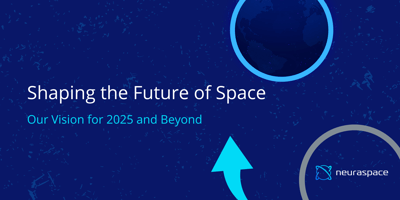Neuraspace ML Model Identifies Space Weather Events
Space weather events, such as solar flares and coronal mass ejections, have profound implications for space traffic management. These events can introduce unforeseen challenges, affecting the accuracy and predictability of satellite orbits
It is November 2023, and the 25th observed solar cycle peak is approaching, estimated to take place in 2025. The increase in solar activity has already been noticed, with the first week of November being characterised by the occurrence of geomagnetic storms, a consequence of coronal mass ejections (CMEs).
Figure 1. Evolution of sunspots from 1975 until 2030. The green lines show the observed sunspots, which are trending toward the red line, which predicts a higher number of sunspots. [source]
The CMEs erupted on the 31st October, 2nd and 3rd November, reaching the Earth’s magnetic field on the 4th and 5th November. The geomagnetic storms generated by these CMEs can have negative consequences on satellite operations which can therefore affect crucial systems such as GPS and Earth observation satellites.
These events were quickly identified by Neuraspace, due to its Machine Learning models. Normally, it is expected that the debris position uncertainty should decrease as the TCA is approached. However, for the week starting on the 5th and finishing on the 12th of November, ≈35% of the LEO conjunctions for this period registered an increase in the secondary object’s position uncertainty values. An example of this behaviour can be seen in Figure 2.
Figure 2. Example of a conjunction taken from the Neuraspace platform where the evolution of the secondary object’s along-track position uncertainty has an unexpected increase in its values.
Machine Learning (ML) has been a trend for the past few years, a trend that is here to stay. With very promising results, it is easy to be taken away and forget that ML is in its core Software, and both Software Engineering and ML best practices should be followed.
Neuraspace aims at providing the most reliable results and is following these best practices by, among others, generating and analysing monitoring reports for its ML models predicting the debris position uncertainty. These reports include, for instance, performance and data drift metrics for conjunctions under its watch.
For the next couple of years and at least until the solar maximum due in 2025 we can expect events such as these geomagnetic storms to become more frequent. It is vital that awareness is brought to the monitoring of solar activity and the impact that it can have on space systems.
Following this concern, Neuraspace is currently improving its state vector propagations by including space weather data and working on developing a new feature for space weather event notifications.


